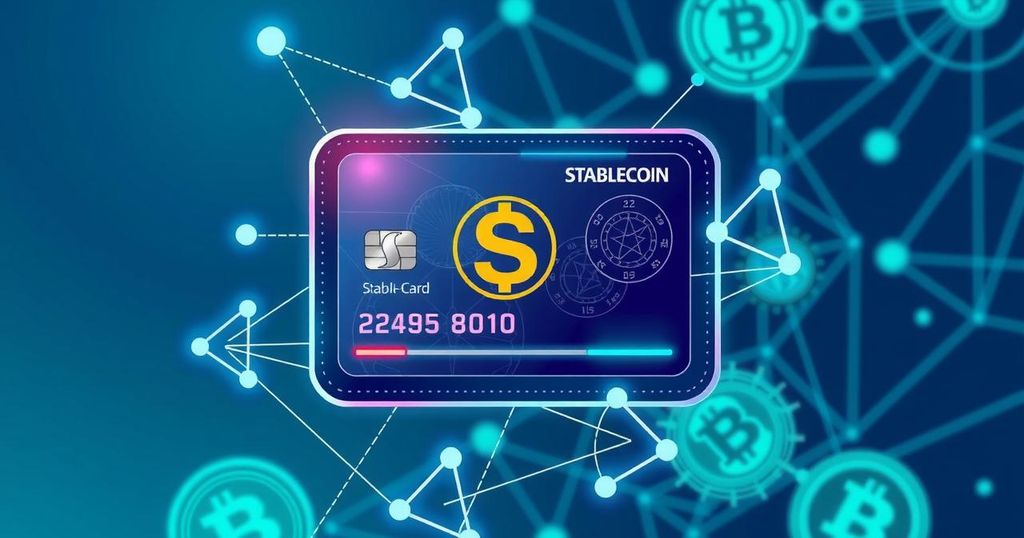Baanx and Visa Partner to Launch Stablecoin Linked Payment Cards
Baanx has partnered with Visa to launch stablecoin-linked cards, allowing users to spend from self-custodial wallets. Initially debuting in the U.S., the cards will facilitate real-time transactions using USDC, addressing the ‘last mile problem’ in crypto spending. This move coincides with Mastercard’s similar strategy, indicating a growing recognition of stablecoins’ practicality.
In an exciting turn of events for the crypto world, Baanx has teamed up with Visa to introduce stablecoin-linked cards that will let users spend directly from their self-custodial wallets. Launching first in the United States, this partnership, announced just days after Mastercard’s similar foray, promises to bring cryptocurrency into mainstream payment systems across the globe.
The Baanx-Visa collaboration allows users to utilise USDC, a fiat-backed stablecoin, at any merchant that accepts Visa. Using smart contracts, it securely transfers stablecoin balances in real time during card transactions. This innovation is seen as a solution to the so-called “last mile problem” in crypto; allowing everyday users to spend digital assets while still adhering to self-custody principles that set crypto apart.
Simon Jones, Chief Commercial Officer at Baanx, shared the ambitions of this partnership. “Access to stable currency is often a luxury in many areas. By facilitating seamless payments with USD-backed stablecoins, we aim to enhance financial access for everyone, especially where traditional banking falls short.”According to Jones, the growth in stable coin usage could change the landscape dramatically in regions with unstable currencies.
Indeed, stablecoins have taken the crypto sector by storm, with market circulation surpassing $200 billion and a substantial number of addresses engaging in transactions monthly—over 30 million as of now. In the first half of 2024, these tokens settled transactions worth more than $2.6 trillion, showing their vast potential for real-world application. Visa’s strategy highlights this recognition, noting that while adoption remains in its infancy, practical applications for stablecoins are on the horizon.
Cuy Sheffield, Visa’s Global Head of Crypto, emphasised that the advancements in blockchains have significantly improved the consumer experience, allowing for more efficient transactions. The Baanx cards, powered by high-performance networks like Ethereum’s layer 2s and Solana, promise customers instant processes, something previous crypto payment solutions struggled to achieve.
Expectations are high that stablecoin-linked cards will proliferate, with Jones predicting that as many as 70% of larger wallets could feature these cards within a year. This collaboration builds upon Baanx’s existing work in the self-custodial space, evidenced by their prior partnership with MetaMask on a similar card initiative.
Interestingly, while self-custodial wallets have garnered millions of users, the percentage of those with linked cards remain small. As Sheffield pointed out, the transition to a larger market will naturally occur as barriers to accessing such cards diminish.
This shift also begs the question: how will traditional banks respond to the rise of self-custodial stablecoin cards? It’s anticipated these products could disrupt existing banking models which rely heavily on customer deposits. Jones illustrated potential new use cases, particularly in the travel industry, whereby instant payments could alleviate friction encountered by travellers.
But perhaps the most powerful impact of stablecoin cards will be seen in emerging markets, where economic instability often hampers financial access. For instance, individuals in Argentina face stringent requirements to open dollar-denominated accounts. Baanx aims to challenge this status quo, allowing users to keep funds in USD whilst spending effortlessly through a simple card.
The ambitious vision for this collaboration, according to Sheffield, stretches far beyond the initial launch. “We’re still in very early stages; however, embedding Visa credentials into self-custodial wallets could revolutionise how users engage with their digital currencies—a seamless integration,” he concluded.




Post Comment